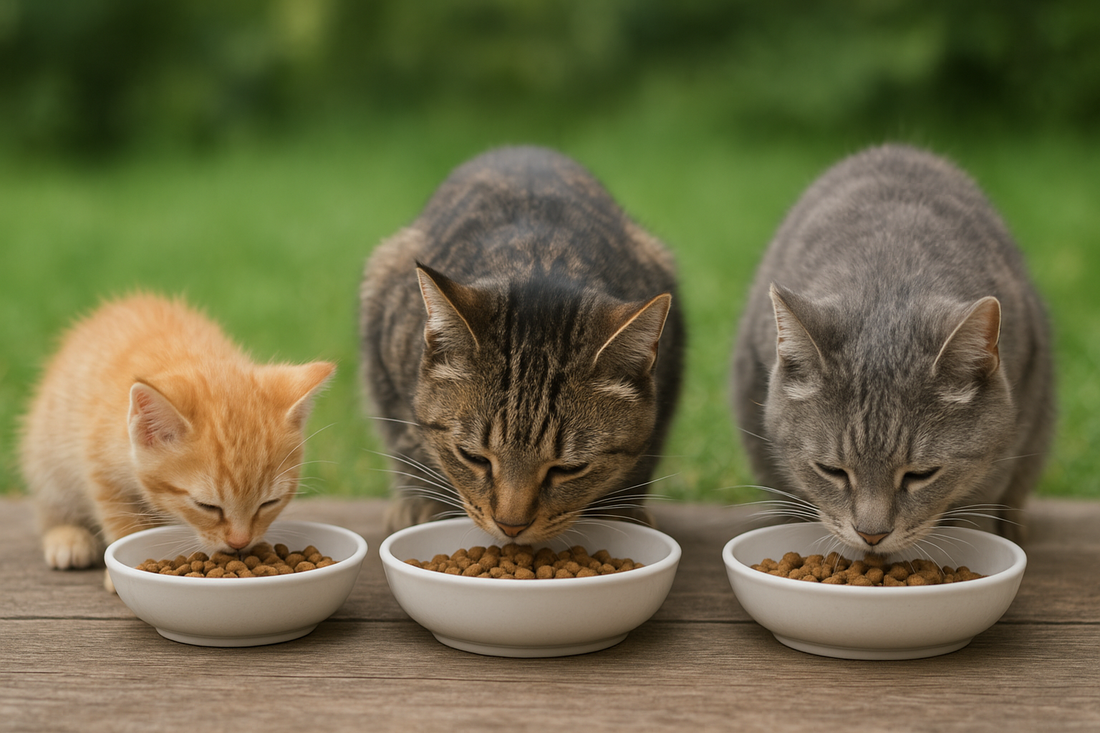
The Ultimate Guide to Choosing the Right Cat Food
Cats are more than just pets — they’re family. And like any family member, their health and well-being start with a proper diet. But with so many options — dry kibble, wet food, grain-free, raw diets — choosing the right cat food can feel overwhelming. This ultimate guide will walk you through everything you need to know to make the best choice for your feline friend, ensuring a long, happy, and healthy life.
Why Choosing the Right Cat Food Matters
 Cats are obligate carnivores, meaning their bodies require nutrients found primarily in animal-based proteins. Feeding your cat the wrong diet can lead to:
Cats are obligate carnivores, meaning their bodies require nutrients found primarily in animal-based proteins. Feeding your cat the wrong diet can lead to:
⦁ Obesity
⦁ Urinary tract issues
⦁ Dental problems
⦁ Life-threatening nutritional deficiencies
A balanced diet helps your cat maintain:
⦁ Healthy weight
⦁ Strong immune system
⦁ Shiny coat
⦁ Optimal energy levels
While treats and table scraps are tempting, they should never replace a nutritionally complete meal. Human foods like onions, garlic, chocolate, and fatty scraps can cause serious health issues, including pancreatitis, kidney strain, or poisoning. Even foods that seem harmless, like milk or tuna, can cause digestive upset or long-term health problems when given in excess.
Understanding Cat Nutritional Needs
 Before selecting a brand or formula, it’s essential to know the nutrients your cat requires:
Before selecting a brand or formula, it’s essential to know the nutrients your cat requires:
1. Protein
Protein provides essential amino acids for growth, tissue repair, and overall health. Look for high-quality animal protein (chicken, fish, turkey) as the first ingredient. Cats need more protein than dogs; insufficient protein can lead to muscle loss, lethargy, poor coat condition, and immune problems.
Kittens, especially, require high-quality protein to support rapid growth, while adult and senior cats need protein to maintain lean muscle mass and prevent age-related muscle loss.
2. Fats
Fats are a concentrated energy source and help absorb fat-soluble vitamins (A, D, E, K). Omega-3 and Omega-6 fatty acids support a shiny coat, healthy skin, heart health, and brain function. DHA and EPA are crucial for kittens’ brain development and adult cats’ heart health.
Too little fat can lead to dry skin, dull coat, and low energy levels. Too much fat can contribute to obesity, so it’s important to strike the right balance based on life stage and activity level.
3. Carbohydrates
Cats can digest carbohydrates but don’t require them in large amounts. Excessive carbs, especially from fillers like corn, wheat, or soy, add calories without nutrition and can contribute to obesity and diabetes. Quality carb sources like peas, lentils, and sweet potatoes provide energy and fiber while being easier to digest.
4. Vitamins and Minerals
Essential vitamins and minerals support bones, immune function, and vision. Taurine, an amino acid, is critical for heart and eye health - deficiencies can be life-threatening. Cats also require calcium, phosphorus, magnesium, and potassium for healthy bones, teeth, and overall metabolism.
5. Water
Cats naturally have a low thirst drive, so hydration is essential. Wet food or a combination of wet and dry food helps prevent urinary issues, kidney problems, and constipation. Providing fresh water at all times, or even using water fountains, encourages hydration, especially for cats on dry food diets.
Types of Cat Food
 Choosing the right type of food is just as important as checking ingredients:
Choosing the right type of food is just as important as checking ingredients:
1. Dry Food (Kibble)
⦁ Pros: Convenient, long shelf life, helps reduce plaque
⦁ Cons: Lower moisture content; can lead to dehydration if water intake is low
Tip: Always provide fresh water, or mix kibble with a bit of water or low-sodium broth. Dry food is also ideal for multi-cat households because it’s easy to store and measure.
2. Wet Food (Canned)
⦁ Pros: High moisture content, more palatable, richer in protein
⦁ Cons: Shorter shelf life once opened; more expensive
Tip: Ideal for cats with urinary issues or poor hydration habits. Wet food also encourages cats to eat more slowly, which can prevent overeating in some cases.
3. Semi-Moist Food
⦁ Pros: Soft texture, convenient
⦁ Cons: Often high in sugar and preservatives; not ideal for long-term nutrition
Tip: Consider semi-moist as a treat rather than a staple diet.
4. Raw or Homemade Diets
⦁ Pros: Full control over ingredients, highly nutritious if balanced
⦁ Cons: Risk of bacterial contamination; time-consuming; requires precise balance
Tip: Consult a veterinary nutritionist before attempting homemade diets to avoid deficiencies, especially in taurine, calcium, and essential vitamins. Homemade diets are best for owners willing to carefully plan, measure, and monitor their cat’s nutrition.
Life Stage and Health Considerations
 Cats’ nutritional needs change as they age:
Cats’ nutritional needs change as they age:
1. Kittens (0–1 year)
⦁ High protein, calories, and fat for growth
⦁ Look for kitten or growth formulas enriched with DHA for brain development
⦁ Avoid adult food, which can stunt growth
Kittens also require more frequent meals (3–4 times a day) to support rapid growth and maintain energy levels.
2. Adult Cats (1–7 years)
⦁ Balanced diet with moderate calories
⦁ Avoid fillers that contribute to obesity
⦁ Monitor weight and adjust portions as needed
Adult cats may eat fewer meals per day, typically 2 meals, but portion control is crucial.
3. Senior Cats (7+ years)
⦁ Reduced calories, increased fiber for digestion
⦁ Formulas supporting joint and kidney health
⦁ Aging cats are less active, so calorie management is crucial
Senior cats also benefit from easily digestible proteins and supplements like glucosamine for joint health, but always under veterinary guidance.
4. Special Needs Cats
Cats with urinary issues, diabetes, allergies, or obesity may require prescription or specialized diets. Always consult a veterinarian — proper diets can significantly improve the quality of life.
Decoding Cat Food Labels
 Understanding labels ensures you choose high-quality food:
Understanding labels ensures you choose high-quality food:
Ingredients List
⦁ Listed by weight; first few should be named animal proteins
⦁ Avoid ambiguous terms like “meat by-products” or excessive fillers
⦁ Ingredients like “chicken meal” or “salmon meal” are highly concentrated protein sources.
Guaranteed Analysis
⦁ Shows nutrient breakdown: protein, fat, fiber, and moisture
⦁ Compare brands to ensure adequate nutrition
⦁ Look for minimum protein and fat percentages, and adequate fiber for digestion.
AAFCO Statement
⦁ Confirms the food meets nutritional standards
⦁ Look for phrases like:
⦁ “Complete and balanced for all life stages”
⦁ “Formulated to meet AAFCO Cat Food Nutrient Profiles”
Common Ingredients to Avoid

⦁ Artificial preservatives: BHA, BHT, ethoxyquin
⦁ Artificial colors/flavors: Unnecessary
⦁ Excessive grains/fillers: Can cause obesity and digestive issues
⦁ Opt for natural preservatives (like mixed tocopherols) and minimal fillers for long-term health.
Choosing Based on Cat Preferences
 Cats can be picky eaters. Consider:
Cats can be picky eaters. Consider:
- Texture: Pâté, chunks, shreds
- Flavor: Rotate gradually to prevent boredom
- Smell: A strong, appealing aroma increases acceptance
Cats are also sensitive to food temperature — slightly warming wet food can make it more enticing.
Trial and observation help find food your cat enjoys without compromising nutrition.
Tips for Transitioning Foods
 Switching diets too quickly can upset digestion. Use this gradual approach:
Switching diets too quickly can upset digestion. Use this gradual approach:
1. Mix 25% new food with 75% old food for 3–4 days
2. Move to 50/50 for 3 days, then 75/25
3. Finish with 100% new food
Monitor for vomiting, diarrhea, or refusal to eat. Patience during this process reduces stress for both you and your cat.
Feeding Guidelines
 Portion control is key to preventing obesity:
Portion control is key to preventing obesity:
⦁ Follow recommended amounts based on weight
⦁ Measure portions; avoid free-feeding if your cat overeats
⦁ Adjust based on activity and body condition
Obesity can lead to diabetes, arthritis, and reduced lifespan. Proper feeding is preventative care.
Wet vs. Dry Food Debate

- Wet food: Supports hydration, urinary health, higher protein content
- Dry food: Convenient, affordable, helps with dental health
Combination diets often work best — dry for crunch and convenience, wet for hydration and taste.
Many experts recommend a mix of wet and dry food for balanced nutrition. If you’re unsure which is best for your cat, explore our detailed article on Wet vs. Dry Cat Food for pros, cons, and feeding tips.
Feeding Multiple Cats
 If you have more than one cat:
If you have more than one cat:
- Separate feeding areas to reduce stress and competition
- Provide different diets if needed
- Supervise feeding to ensure each cat gets the proper portion
For shy or senior cats, timed feeders or separate rooms can reduce mealtime anxiety and prevent food guarding.
Budget-Friendly Options
 High-quality cat food doesn’t have to break the bank:
High-quality cat food doesn’t have to break the bank:
- Look for AAFCO-certified store brands
- Buy in bulk; ensure proper storage
- Check for coupons or promotions
Cheap food may save money short-term but can increase vet costs if nutrition is poor. Investing in your cat’s health early prevents expensive treatments later.
Common Mistakes to Avoid

- Feeding human food excessively
- Ignoring age-specific needs
- Changing food too abruptly
- Over-relying on treats (>10% of daily calories)
Avoiding these mistakes ensures a healthy, happy cat.
Along with a balanced diet, providing enrichment and safe scratching posts can help protect your furniture - learn more in our guide on How to Stop Your Cat from Scratching Furniture
Supplements: Do Cats Need Them?
 Balanced commercial diets rarely require supplements. However:
Balanced commercial diets rarely require supplements. However:
- Omega-3 fatty acids: Support coat and joints
- Probiotics: Aid digestion, especially in sensitive cats
Always consult a vet before adding supplements; over-supplementation can be harmful.
Monitoring Your Cat’s Health
 Even with ideal nutrition, regular checks are essential:
Even with ideal nutrition, regular checks are essential:
- Monthly weight monitoring
- Observe coat condition; shiny, smooth fur indicates good nutrition
- Watch energy levels; lethargy may indicate deficiencies
- Regular vet visits catch issues early
Additional monitoring includes checking urination frequency, appetite, and dental health, as these often reflect dietary adequacy.
Lifestyle-Based Feeding
 Your cat’s environment and activity level affect dietary needs:
Your cat’s environment and activity level affect dietary needs:
- Indoor cats: Less active; fewer calories, more fiber
- Outdoor cats: Higher-calorie diets for energy
- Active/working cats: Protein and fat-rich diets
Matching food to lifestyle supports weight management and overall health.
Sustainable and Ethical Options
Consider environmental impact and animal welfare:
- Ethically sourced proteins
- Sustainable packaging (biodegradable/recyclable)
- Grain-free diets may help sensitive cats, but are not inherently healthier
Sustainable options allow you to care for your cat and the planet.
Final Thoughts
Choosing the right cat food doesn’t have to be stressful. Focus on:
- High-quality protein
- Balanced nutrition
- Life-stage-appropriate formulas
- Pairing wet and dry foods for best results
Your veterinarian is a key partner — ask for guidance on specialized diets or health concerns.
With the right food, your cat will enjoy a long, healthy, and happy life — and you’ll have peace of mind knowing you’re providing the best care possible. 🐱❤️

Tags: Cat Nutrition, Best Cat Food, Cat Diet Guide, Indoor Cats, ,Kitten Food, Senior Cats, Wet vs Dry Cat Food, Healthy Cats, Cat Feeding Tips, Pet Care
